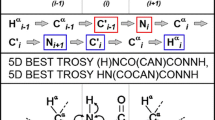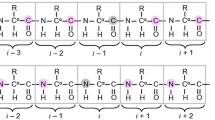Abstract
The characterization of the conformational properties of intrinsically disordered proteins (IDPs), and their interaction modes with physiological partners has recently become a major research topic for understanding biological function on the molecular level. Although multidimensional NMR spectroscopy is the technique of choice for the study of IDPs at atomic resolution, the intrinsically low resolution, and the large peak intensity variations often observed in NMR spectra of IDPs call for resolution- and sensitivity-optimized pulse schemes. We present here a set of amide proton-detected 3D BEST-TROSY correlation experiments that yield the required sensitivity and spectral resolution for time-efficient sequential resonance assignment of large IDPs. In addition, we introduce two proline-edited 2D experiments that allow unambiguous identification of residues adjacent to proline that is one of the most abundant amino acids in IDPs. The performance of these experiments, and the advantages of BEST-TROSY pulse schemes are discussed and illustrated for two IDPs of similar length (~270 residues) but with different conformational sampling properties.






Similar content being viewed by others
References
Bermel W, Bertini I, Felli IC, Gonnelli L, Kozminski W, Piai A, Pierattelli R, Stanek J (2012) Speeding up sequence specific assignment of IDPs. J Biomol NMR 53:293–301
Csizmok V, Felli IC, Tompa P, Banci L, Bertini I (2008) Structural and dynamic characterization of intrinsically disordered human securin by NMR spectroscopy. J Am Chem Soc 130:16873–16879
Davey NE, Trave G, Gibson TJ (2011) How viruses hijack cell regulation. Trends Biochem Sci 36:159–169
Dunker AK, Lawson JD, Brown CJ, Williams RM, Romero P, Oh JS, Oldfield CJ, Campen AM, Ratliff CR, Hipps KW, Ausio J, Nissen MS, Reeves R, Kang CH, Kissinger CR, Bailey RW, Griswold MD, Chiu M, Garner EC, Obradovic Z (2001) Intrinsically disordered protein. J Mol Graph Model 19:26–59
Farjon J, Boisbouvier J, Schanda P, Pardi A, Simorre JP, Brutscher B (2009) Longitudinal relaxation enhanced NMR experiments for the study of nucleic acids in solution. J Am Chem Soc 131:8571–8577
Farrow NA, Muhandiram R, Singer AU, Pascal SM, Kay CM, Gish G, Shoelson SE, Pawson T, Formankay JD, Kay LE (1994) Backbone dynamics of a free and a phosphopeptide-complexed Src homology-2 domain studied by 15 N NMR relaxation. Biochemistry 33:5984–6003
Favier A, Brutscher B (2011) Recovering lost magnetization: polarization enhancement in biomolecular NMR. J Biomol NMR 49:9–15
Felli IC, Brutscher B (2009) Recent advances in solution NMR: fast methods and heteronuclear direct detection. Chem Phys Chem 10:1356–1368
Feuerstein S, Plevin MJ, Willbold D, Brutscher B (2012a) iHADAMAC: a complementary tool for sequential resonance assignment of globular and highly disordered proteins. J Magn Reson 214:329–334
Feuerstein S, Solyom Z, Aladag A, Favier A, Schwarten M, Hoffmann S, Willbold D, Brutscher B (2012b) Transient structure and SH3 interaction sites in an intrinsically disordered fragment of the hepatitis C virus protein NS5A. J Mol Biol 420:310–323
Geen H, Freeman R (1991) Band-selective radiofrequency pulses. J Magn Reson 93:93–141
Grzesiek S, Bax A (1993) Amino-acid type determination in the sequential assignment procedure of uniformly 13C/15 N-enriched porteins. J Biomol NMR 3:185–204
Kumar D, Paul S, Hosur RV (2010) BEST-HNN and 2D-(HN)NH experiments for rapid backbone assignment in proteins. J Magn Reson 204:111–117
Kupce E, Freeman R (1994) Wide-band excitation with polychromatic pulses. J Magn Reson A 108:268–273
Lescop E, Schanda P, Brutscher B (2007) A set of BEST triple-resonance experiments for time-optimized protein resonance assignment. J Magn Reson 187:163–169
Lescop E, Rasia R, Brutscher B (2008) Hadamard amino-acid-type edited NMR experiment for fast protein resonance assignment. J Am Chem Soc 130:5014–5015
Lescop E, Kern T, Brutscher B (2010) Guidelines for the use of band-selective radiofrequency pulses in hetero-nuclear NMR: example of longitudinal-relaxation-enhanced BEST-type H-1-N-15 correlation experiments. J Magn Reson 203:190–198
Lohr F, Pfeiffer S, Lin YJ, Hartleib J, Klimmek O, Ruterjans H (2000) HNCAN pulse sequences for sequential backbone resonance assignment across proline residues in perdeuterated proteins. J Biomol NMR 18:337–346
Mantylahti S, Aitio O, Hellman M, Permi P (2010) HA-detected experiments for the backbone assignment of intrinsically disordered proteins. J Biomol NMR 47:171–181
Mcintosh LP, Kang HS, Okon M, Nelson ML, Graves BJ, Brutscher B (2009) Detection and assignment of phosphoserine and phosphothreonine residues by (13)C-(31)P spin-echo difference NMR spectroscopy. J Biomol NMR 43:31–37
Panchal SC, Bhavesh NS, Hosur RV (2001) Improved 3D triple resonance experiments, HNN and HN(C)N, for H-N and N-15 sequential correlations in (C-13, N-15) labeled proteins: application to unfolded proteins. J Biomol NMR 20:135–147
Pervushin K, Riek R, Wider G, Wüthrich K (1997) Attenuated T-2 relaxation by mutual cancellation of dipole–dipole coupling and chemical shift anisotropy indicates an avenue to NMR structures of very large biological macromolecules in solution. Proc Natl Acad Sci USA 94:12366–12371
Pervushin K, Vögeli B, Eletsky A (2002) Longitudinal H-1 relaxation optimization in TROSY NMR spectroscopy. J Am Chem Soc 124:12898–12902
Schanda P (2009) Fast-pulsing longitudinal relaxation optimized techniques: enriching the toolbox of fast biomolecular NMR spectroscopy. Prog NMR Scpectrosc 55:238–265
Schanda P, Van Melckebeke H, Brutscher B (2006) Speeding up three-dimensional protein NMR experiments to a few minutes. J Am Chem Soc 128:9042–9043
Schubert M, Ball LJ, Oschkinat H, Schmieder P (2000) Bridging the gap: a set of selective H-1-N-15-correlations to link sequential neighbors of prolines. J Biomol NMR 17:331–335
Schulte-Herbruggen T, Sorensen OW (2000) Clean TROSY: compensation for relaxation-induced artifacts. J Magn Reson 144:123–128
Smith MA, Hu H, Shaka AJ (2001) Improved broadband inversion performance for NMR in liquids. J Magn Reson 151:269–283
Tompa P (2002) Intrinsically unstructured proteins. Trends Biochem Sci 27:527–533
Tompa P (2012) Intrinsically disordered proteins: a 10-year recap. Trends Biochem Sci 37:509–516
Uversky VN, Dunker AK (2010) Understanding protein non-folding. BBA-proteins proteom 1804:1231–1264
Wright PE, Dyson HJ (1999) Intrinsically unstructured proteins: re-assessing the protein structure-function paradigm. J Mol Biol 293:321–331
Xue B, Williams RW, Oldfield CJ, Goh GKM, Dunker AK, Uversky VN (2010) Viral disorder or disordered viruses: do viral proteins possess unique features? Protein Peptide Lett 17:932–951
Acknowledgments
We are grateful to Isabel Ayala and Adrien Favier for help in protein production and technical support. This work has been supported by grants from the European Commission (FP7-ITN IDPbyNMR contract No. 264257 and FP7-I3 BIO-NMR contract No. 261863), from the DFG (SFB974, A11), and from the Austrian Science Foundation FWF (W1221-B03 and P 20549-N19).
Author information
Authors and Affiliations
Corresponding author
Electronic supplementary material
Below is the link to the electronic supplementary material.
Rights and permissions
About this article
Cite this article
Solyom, Z., Schwarten, M., Geist, L. et al. BEST-TROSY experiments for time-efficient sequential resonance assignment of large disordered proteins. J Biomol NMR 55, 311–321 (2013). https://doi.org/10.1007/s10858-013-9715-0
Received:
Accepted:
Published:
Issue Date:
DOI: https://doi.org/10.1007/s10858-013-9715-0




